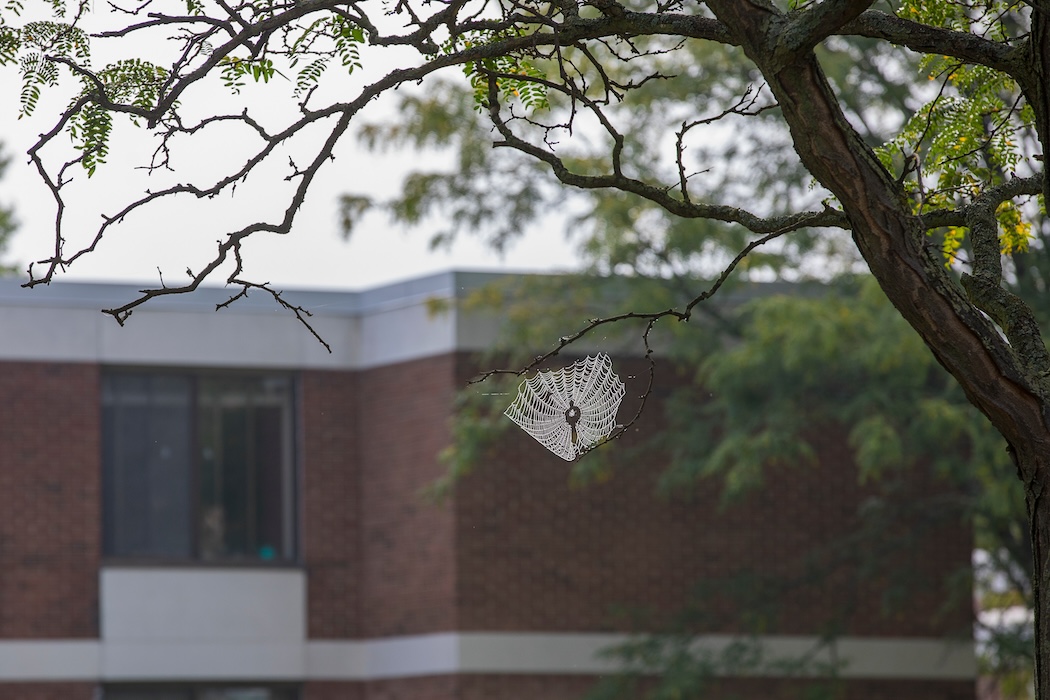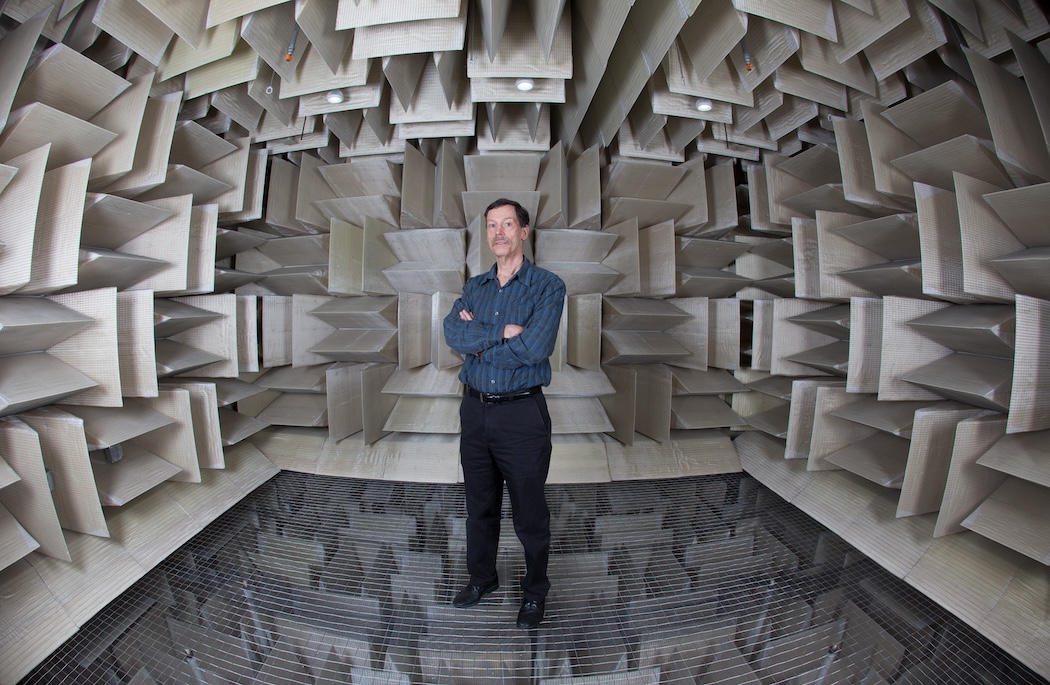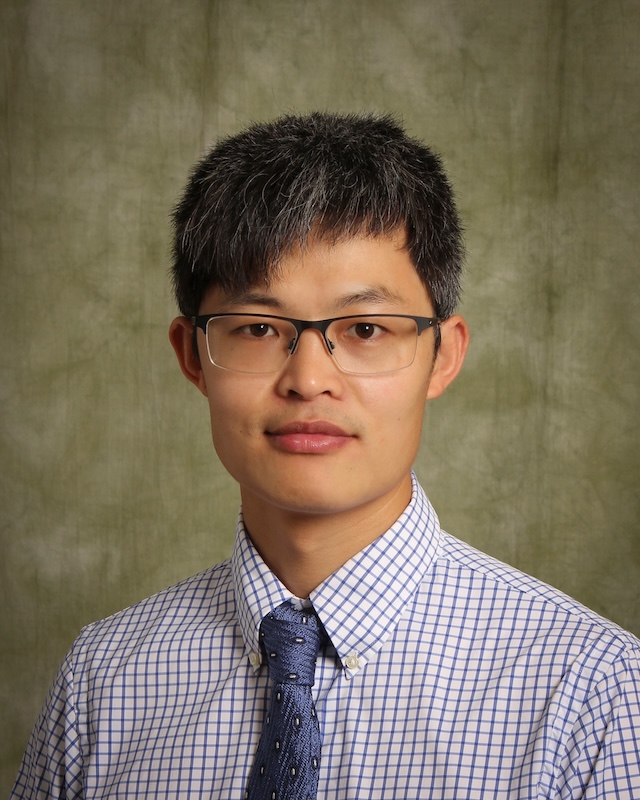Thinner than hair, stronger than steel — and able to hear? How spider silk research led to a new kind of microphone
Binghamton University faculty patent bio-inspired microphone technology

The human ability to notice the world around us is made possible by our sense organs — eyes, ears, nose, skin and tongue — which are so efficient that most people don’t consciously think about them. Others, like Distinguished Professor of Mechanical Engineering Ron Miles, have always had a “sense” for them.
“I have been interested in sound for some odd reason ever since I can remember. As I’ve learned more, I’ve realized that hearing could be argued as the most important sense,” Miles said. “[Losing] vision takes you away from things, but hearing, if you lose that, takes you away from people. Hearing is really the most important method of communication for us — and for all animals.”
In 1876, Alexander Graham Bell patented the first microphone. Nearly 150 years later, Miles is working to revolutionize audiology again — this time, by turning to nature.
Using biomimicry as a model, Miles worked with then-doctoral student Jian Zhou on his thesis project; the pair would go on to pioneer and patent the bio-inspired flow microphone — the very patent that has now been commercialized by the Canadian venture firm TandemLaunch and its spin-off company Soundskrit, which has also recently released both an analog and digital version of Miles’ original concept.
Yet to understand why this patent is a revolutionary advancement in technology, one has to understand: How do microphones work? And, what really is sound?
“Sound is essentially a fluctuation. We hear sound because of our eardrums. Our ears have little drums, little surfaces, or tympana, membranes that are driven by changes in pressure. Tiny changes in the atmospheric pressure cause our eardrums to move, and then our ears detect that motion,” Miles said. “Things like mosquitoes and crickets and midges — they hear using little hairs, and those hairs are driven by motion in the air that’s part of the sound field.”
This essential difference is what makes biomimicry such an interesting perspective to pursue. Microphones work by taking a sound wave and turning it into an electrical signal; most are modeled after the human ear and its ability to sense pressure. However, there are other ways to “hear,” and many animals to mimic.
Unfortunately, sometimes working with animals can be a bit of a hurdle — like the time Miles’ collaborators at Cornell University brought some female mosquitos to Binghamton for research.
“They got out, and they were everywhere. All over the first floor of the Engineering and Science Building! It was like being up in the [Binghamton University] Nature Preserve in July,” he said. “They were just biting everybody — it was awful. And this went on for a couple of weeks.”
Other animals, though, are easier to manage. One — spiders — listen in a distinctly unique way, using the webs they spin in addition to the small hairs on their bodies that sense motion.
Zhou and Miles were the first to realize this by conducting research that started with a walk.
“[Zhou] took a walk in the Nature Preserve, came back and said, ‘Hey, there was a spiderweb blowing in the breeze. It moves in response to wind, and it’s strong stuff.’ He then borrowed a spider from the Nature Preserve and brought it back to the lab,” Miles said. “The silk responded to sound beautifully. And it responded to the motion of the air in the sound field, which was really a first. It responded so well that it acted like a perfect microphone. It could respond to sound with perfect fidelity all the way from like 1 hertz up to 50 kilohertz, a way broader frequency range, with a flatter frequency response, than any microphone!”
In theory, Miles and Zhou thought, this might mean that a microphone using the same structural properties as a spider’s web — sensing sound using velocity — could reproduce audio with the same amplitude quality or “good fidelity” at high and low frequencies. Using both components, velocity and pressure, they reasoned, might result in a more complete description of the sound field.
To test it, the pair turned to Binghamton University’s anechoic chamber, a soundproof room on the bottom floor of the Engineering and Science Building, where they can control the environment and prevent disruption in their data collection.
Miles and Zhou were lucky when it came to choosing spider silk. Although other animals may have shown similar results, silk has a special property that aided their ability to test it and helped them come to the conclusions that resulted in a successful patent.
“Instead of something that’s supported only on one end, [silk is] supported on both ends. We knew it had to be very lightweight and very flexible; you don’t want it to float away. You’ve got to hold it down somehow. Supporting it on each end made it easier,” Miles said. “The truth is, in nature, there are just countless systems out there that sense this way. And you have to go out and look at them and decide which one you can actually make.”
New, potential research goals could look at how to make structures that are more cantilever, like a hair sticking up. Many animals are covered in small hairs that assist in hearing. Other ways forward could look at how sound is transmitted through motion in water rather than air.
Meanwhile, the work to make this a usable product for the general public continues. Looking to improve audio capture in consumer devices, Soundskrit began its first task — considering universities and research worldwide to see where to invest. It wasn’t long before the company realized no one else was doing what Miles and Zhou were working on.
“What we found was that most people seemed to be taking more or less the same approach. They took the microphone as a given component and relied on using lots of them with software to try and isolate a user’s voice from background noise,” said Sahil Gupta, co-founder of Soundskrit. “By improving the underlying hardware, everything else on top of that would only be improved. Paired with some really incredible results and a truly unique story, we saw how differentiated this approach was.”
The patent is not the end of the line for this research. Even as Soundskrit begins mass production and distribution, Miles and Zhou continue to use the fundamental information they gleaned from the research to advance their upcoming work. While Zhou hopes to continue advancing auditory nanotechnology, Miles recently began a project with a National Institutes of Health RO1 grant to study acoustic flow in ears and improve treatments for hearing loss and other auditory problems.
Whether aimed at consumers, healthcare or research, the work completed with this patent could profoundly transform how we hear and lead to radical technological advances — with research that began in a University basement.
“If you had another way to make the microphone that didn’t even sense pressure, it would introduce a new design approach. You just throw away your old design and start with a new principle; it will have different constraints. And it may be much easier to meet some of the requirements in the design, and more practical to make a really good-sounding microphone,” Miles said. “Maybe in that case, making it really small is not a problem. A cell phone microphone will be as good as a recording studio microphone.”


